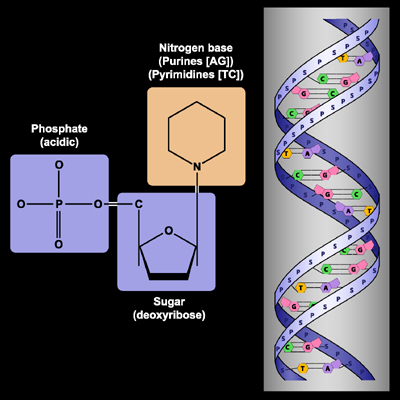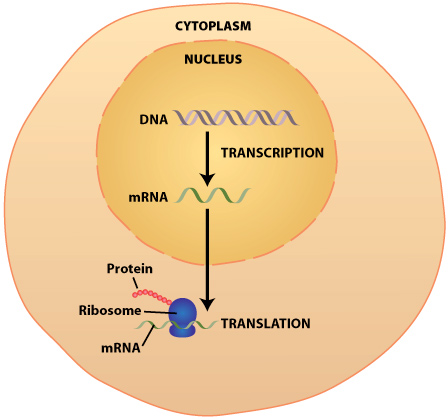DNA Structure
DNA (deoxyribonucleic acid) is a large molecule containing the genes that code instructions for the synthesis of proteins. The code consists of a sequence of repeating subunits, or nucleotides. Each nucleotide has three parts:
- a phosphate group (an acid),
- a sugar (in the case of DNA, deoxyribose), and
- a ring of carbon and nitrogen atoms (the nitrogen can form a bond with hydrogen so the nucleotide is basic).
A chain of nucleotides (nucleic acids) is formed by linking the phosphate group of one nucleotide to the sugar of an adjacent nucleotide. The bases stick out from the side of the phosphate-sugar backbone. The 3rd component described above, the base consisting of a ring of carbon and nitrogen atoms, occurs in 4 forms for DNA. These bases can be divided into two classes: the purine bases (adenine and guanine), which have double rings of nitrogen and carbon atoms, and the pyrimidine bases (cytosine and thymine), which have only a single ring.
A molecule of DNA consists of two polynucleotide chains coiled around each other in the form of a double helix. The chains are held together by hydrogen bonds between purine and pyrimidine bases – specifically, adenine is paired with thymine and guanine is paired with cytosine. Thus, one chain in the double helix is complementary to the other.
 From: www.thepepproject.net P = phosphate; S = sugar
From: www.thepepproject.net P = phosphate; S = sugar
Protein Synthesis
DNA is “read” by using three-base sequences to form “words” that direct the production of specific amino acids. These three-base sequences, known as triplets, or codons, are arranged in a linear sequence along the DNA. A linear stretch of DNA that codes for a specific protein is called a gene. The entirety of genes in the human population is termed the human genome.
Most of the DNA is contained in the nucleus of the cell (a small amount is in the mitochondria), yet most protein synthesis occurs in the cytoplasm of the cell. Since DNA molecules are too large to pass through the nuclear membrane into the cytoplasm, a message must carry the genetic information from the nucleus into the cytoplasm. This message is carried by messenger RNA (mRNA; ribonucleic acid) molecules, small single-stranded nucleic acids that contain the coding information of individual genes. The passage of information from DNA to mRNA in the nucleus is called transcription because an individual gene’s DNA sequence is actually transcribed into a corresponding RNA.
Then, the mRNA moves into the cytoplasm where it directs the assembly of a specific sequence of amino acids to form the gene’s protein – this process is called translation. Translation occurs on ribosomes either free in the cytoplasm or attached to the endoplasmic reticulum. Thus, the synthesis of a protein is governed by the information in its DNA, with the help of messengers (mRNA) and translators (tRNA).
 In the nucleus, DNA is transcribed to RNA. The mRNA carries the message out of the nucleus to the ribosome in the cytoplasm where the tRNA helps translate the message to make a protein.
In the nucleus, DNA is transcribed to RNA. The mRNA carries the message out of the nucleus to the ribosome in the cytoplasm where the tRNA helps translate the message to make a protein.